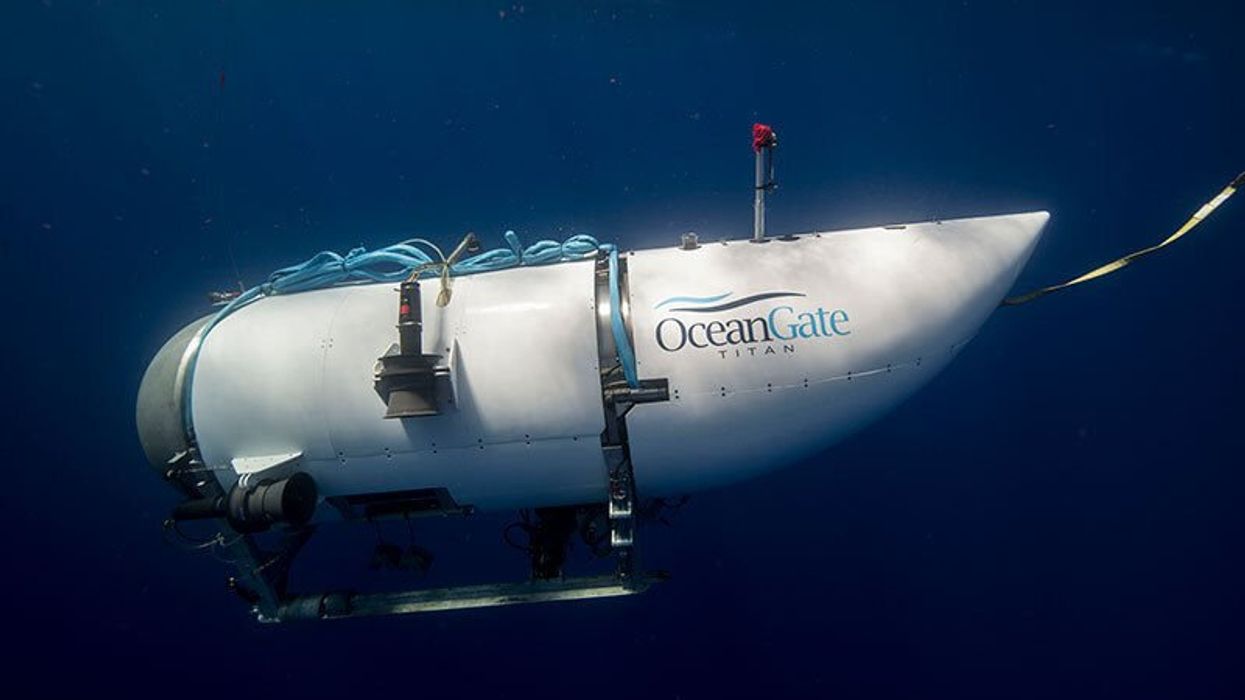
Ocean Gate / Handout/Anadolu Agency via Getty Images

A multinational search and rescue mission had been launched to save the OceanGate submersible that went missing in the Atlantic Ocean on Sunday. However, the recovery operation was halted after the U.S. Coast Guard announced that the tail cone and debris from the Titan sub were found on the ocean floor approximately 1,600 feet from the bow of the Titanic – which lies around 12,500 feet below sea level.
The vessel is said to have suffered a "catastrophic implosion," which caused the deaths of all five people on board. The submersible imploded roughly 900 miles off the coast of Cape Cod.
The international rescue operation involved the United States, Canada, France, and England.
According to USA Today, the U.S. military sent three C-130 aircraft and three C-17 transport planes for the search effort, while the Canadian military dispatched a P8 aircraft with sound-sensing equipment.
The U.S. Navy deployed several remotely operated vehicles, or ROVs, to scan the sea floor near the Titanic wreck to locate the missing submersible.
The news outlet added, "Aiding the search was a French team specializing in ROVs and an expert submariner from the British Royal Navy. Also helping are experts including some from the Woods Hole Oceanographic Institution."
There were several vessels sent to the North Atlantic to assist in the search for the doomed submersible.
Included was a Canadian Coast Guard fishery science vessel with an "advanced deep sonar," a 307-foot Canadian vessel for operating ROVs, a Canadian ship with a mobile decompression chamber for any survivors of the Titan, and a French multipurpose research vessel with an ROV that can dive nearly 20,000 feet deep, according to CNN.
The U.S. Coast Guard announced on Wednesday, "The Navy is sending subject matter experts and a Flyaway Deep Ocean Salvage System (FADOSS), a motion-compensated lift system designed to provide reliable deep ocean lifting capacity for the recovery of large, bulky, and heavy undersea objects such as aircraft or small vessels, from Navy Supervisor of Salvage."
A private Bahamian research ship also assisted in the search for the 21-foot submersible.
The operation was not able to recover the Titan sub because it imploded on Sunday.
A new report said the U.S. Navy "detected an anomaly consistent with an implosion or explosion in the general vicinity of where the Titan submersible was operating when communications were lost" on Sunday. An insider claimed that the military didn't inform the public because officials were not 100% certain that the sound was the Titan imploding.
The extensive rescue operation ran up a massive bill.
The rescue mission would "probably cost millions," according to Chris Boyer, the executive director of the National Association for Search and Rescue, an organization "interested in the training of search and rescue, disaster relief, emergency medicine, and awareness education."
The New York Times reported, "The expense for such an endeavor is likely to be equally great, and it is unclear whether taxpayers in the countries involved, ultimately, will be required to pay it."
Ret. Adm. Paul Zukunft, who previously led the Coast Guard, told the Washington Post that OceanGate Expeditions would not need to pay the U.S. government for the rescue attempt.
Zukunft said, "It's no different than if a private citizen goes out and his boat sinks. We go out and recover him. We don't stick them with the bill after the fact."
Hawaii, Idaho, Maine, New Hampshire, Oregon, and Vermont have laws allowing state officials to seek reimbursement from individuals who needed to be rescued if they acted negligently, according to the New York Times.
The passengers paid $250,000 each for the submersible journey to the Titanic wreck. It is not known whethere the passengers took out travel insurance for the risky underwater expedition.
The passengers were reportedly required to execute a "release of liability agreement" with OceanGate Expeditions.
The agreement states that the passengers would "assume full responsibility for the risk of bodily injury, disability, death and property damage due to the negligence of [OceanGate] while involved in the operation."
The New York Post noted, "The three-page document spells out the risks that passengers take when riding in the 23,000-pound Titan, including eye-popping wording such as how the craft 'has not been approved or certified by any regulatory body and may be constructed of materials that have not been widely used on human occupied submersible.'"
The agreement states, "As lawful consideration for being permitted to participate in the operation, and on behalf of myself, my heirs, assigns, personal representative, estate, and for all members of my family, including minor children, I hereby release, waive, and forever discharge OceanGate Expeditions, Ltd."
The five people who died on the Titan were OceanGate founder Stockton Rush, British billionaire Hamish Harding, French Titanic expert Paul-Henri Nargeolet, Pakistani billionaire businessman Shahzada Dawood, and his 19-year-old son, Sulaiman.
Like Blaze News? Bypass the censors, sign up for our newsletters, and get stories like this direct to your inbox. Sign up here!
Titan submersible implosion: Experts describe extreme conditions of the deep oceanwww.youtube.com